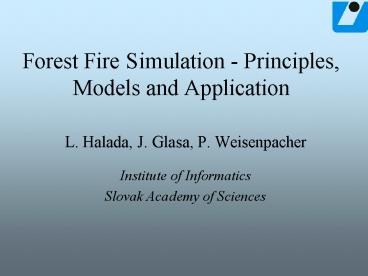Forest Fire Simulation Principles, Models and Application PowerPoint PPT Presentation
1 / 24
Title: Forest Fire Simulation Principles, Models and Application
1
Forest Fire Simulation - Principles, Models and
Application
- L. Halada, J. Glasa, P. Weisenpacher
- Institute of Informatics
- Slovak Academy of Sciences
2
Motivation - Forest Fires in Slovenský Raj
National Park 1994-1998
3
Scientific Goals
- Further improvement of the computational model
applied. - To test methods of data analysis to precise the
input parameters.
4
Practical Goals
- Creation of a decision support system for a
protection of selected areas. - As a means provided to a training centre for
practical implementation. - As a tool for universities, ecosystem
institutions, insurance companies, etc.
5
Basic Principles - Conservation Equations
6
Difficulties of the Problem
- Complex structure of the wildland forest geometry
- Complexity of chemical and physical dynamics of
combustion - Turbulence
- Meteorological conditions and their dependence on
fire-induced air flows
7
Envelope Models Huygens principle
- A fire ignited at a point will expand under
constant conditions and homogeneous fuel as an
ellipse - Elliptic shape of fire depending on wind, slope
and fuel - Secondary fires grow from the each point of the
actual fire perimeter - Envelope that encompasses all small ellipses
gives a fire perimeter in the next instant
8
Principles of the Propagation in Envelope Model
Step I
- Local fire
- x(?,t) a. t . cos(?)
- y(?,t) c. t b. t . sin(?)
- 0 ? ? ? 2?
- bc, b-c, a forward, backward and lateral rate
of fire spread
9
Principles of the Propagation in Envelope Model
Step II
- Huygens principle
- Ellipses generated in points (x(i), y(i)), i
1,2 . - New fire front is defined by the envelope of the
ellipses generated at each point of the fire line.
10
Huygens principle
- Constant wind direction, variable fuel
- Changed wind direction, constant fuel
11
Envelope Model - Practical Application
- Correction to non-zero slope
- Evaluation of the value ? the angle of the
resultant wind-slope vector (Rothermel 1972) - Length to breath (LB) and head to back (HB) ratio
(Anderson 1983) of the ellipse
12
Envelope Model - Practical Application
- Steady-state fire spread rate (Albini 1976,
Rothermel 1972) - R - steady state spread rate IR -
reaction intensity, - p - propagating flux ratio ?b - bulk
density - e - effective heating number Qi - heat of
pre-ignition - FW - wind coefficient FS -slope
coefficient
13
Envelope Model - Practical Application
- Semi-axes of the ellipse
14
Envelope Model - Differential Equation for
Fireline Propagation
- Fireline is represented by a polygon
consisting of series of 2D vertices
15
FARSITE (Fire Area Simulator) developed by M. A.
Finney (1994)
- program using envelope model for 2D numerical
forest fire growth simulation in given area with
given - weather conditions
- fuel type
- topography
16
The Use of FARSITE
- Simulation of past fires reconstruction A
comparison of the simulated fires with the known
fire growth pattern. Validation. - Simulation of active fires Decision support and
the computation-based control under given
conditions. - Simulation of potential fires prevention
Analyses of the possibility of their suppression
under various conditions.
17
Additional models used in FARSITE
- Crown fire model
- Acceleration model
- Spotting model
- Fuel moisture model
- Postfrontal combustion model
18
Input data
- Topography data (GIS)
- - elevation, slope, aspect
- Fuel data (GIS)
- - surface fuel model, canopy cover, stand
height, - crown base height, crown bulk density
- Meteorological data (Text)
- - wind direction, wind speed, temperature,
- relative humidity, precipitation
19
Surface Fuel Model Data
- Fuel loading
- - the mass of the fuel per unit area grouped
by the particle size classes (1h, 10h, 100h dead
fuel, live woody, live herbaceous) - Surface area to volume ratio of each size group
- Fuel depth (m)
- Moisture of extinction ()
- Heat content of the dead and live fuel (kJ.kg-1 )
20
Output Data
- Raster files, ARCVIEW Shapefiles, vector files
(.vct) - Graphs, tables, pictures
21
Forest Fire in the Slovenský Raj National Park
(23.10.2000)
- The burnt area 64 ha
- 6 volunteers lost their lives
- Cost of the fire protection 5,8 mil. Sk
- Damage 356 mil. Sk
- ----------------------
- Topography hills and valleys
- Cover conifers (spruce, fir) 80
- maple, beech
20
22
Assumptions of our simulation
- Real data for topography (elevation, aspect,
slope) and canopy cover (TU Zvolen) - Original fuel model TER, elaborated by intensive
terrain measurements (TU Zvolen) - Meteorological data for wind, temperature and
humidity from meteorological stations in Poprad
and Telgart (TU Zvolen)
23
The Results of our Simulation
24
Real Fire Behavior

